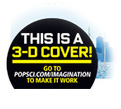Interactive magazine cover. Almost reality
Imagine. You buy a magazine. An ordinary glossy magazine with a bright cover. It is not so important about what exactly this magazine will be - IT, cars, women, whatever. And suddenly you notice on its cover something like this:

First thoughts? Stereooblazka, and inside colored glasses? Autostereogram ? Everything is simpler and more elegant.
In general, if you look at the picture above, you can see a short instruction that encourages us to visit a certain site in order to make the whole thing work.
')
And really. This cover does not contain absolutely nothing unusual except for some kind of control image that is recognized by the flash application on the site, which will be used by your webcam to which you will bring this wallpaper. And then the following will happen:
As it becomes clear from the video, this magazine is no other than Popular Science. Here is sobsno, their cover in full:

Want to try? It is not necessary to order a magazine. You can just print this one cover on a color printer, go to the site of the joint project PopularScience and General Electric (yes, this is actually a GE advertisement), poke at the Launch Experience, bring a freshly printed cover to your face, smile at the camera and watch the effect .
It is clear that in this case it is just an example of technology, but if you turn on the fantasy, then that just does not come to mind. The most banal - animated infographics. That is, you sit reading a magazine. What a thread smart article with a bunch of information. In principle, everything is clear, but there is a footnote in the text: “To see a more detailed interactive scheme, go to such and such a site and bring the spread to the webcam.” Don't you go in?
The truth here is the question - if you really still need to go to the site, then why not put this very animated table directly on the site. In this case, this feature with recognition becomes an additional link, without which you can do.
But, in any case, the technology, it seems to me, is quite promising.

First thoughts? Stereooblazka, and inside colored glasses? Autostereogram ? Everything is simpler and more elegant.
In general, if you look at the picture above, you can see a short instruction that encourages us to visit a certain site in order to make the whole thing work.
')
And really. This cover does not contain absolutely nothing unusual except for some kind of control image that is recognized by the flash application on the site, which will be used by your webcam to which you will bring this wallpaper. And then the following will happen:
As it becomes clear from the video, this magazine is no other than Popular Science. Here is sobsno, their cover in full:

Want to try? It is not necessary to order a magazine. You can just print this one cover on a color printer, go to the site of the joint project PopularScience and General Electric (yes, this is actually a GE advertisement), poke at the Launch Experience, bring a freshly printed cover to your face, smile at the camera and watch the effect .
It is clear that in this case it is just an example of technology, but if you turn on the fantasy, then that just does not come to mind. The most banal - animated infographics. That is, you sit reading a magazine. What a thread smart article with a bunch of information. In principle, everything is clear, but there is a footnote in the text: “To see a more detailed interactive scheme, go to such and such a site and bring the spread to the webcam.” Don't you go in?
The truth here is the question - if you really still need to go to the site, then why not put this very animated table directly on the site. In this case, this feature with recognition becomes an additional link, without which you can do.
But, in any case, the technology, it seems to me, is quite promising.
Source: https://habr.com/ru/post/65715/
All Articles